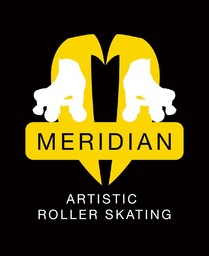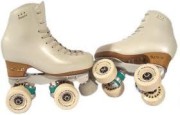
Skates
Artistic roller skaters most commonly skate on traditional quad skates. Skates designed for artistic skating typically have leather boots, a strong sole plate, and a jump bar for reinforcement. The plate has to be made from a strong material as it has to be able to withstand the shock of jumping and landing. Artistic roller skates usually have stainless steel or aluminium plates for that reason, even though these are heavier than ones made from other materials such as plastic. Free skaters usually use a toe stop, which can be used in the take-off in certain jumps.
Roller Wheels & Bearings
Roller skate wheels come in many different sizes and hardnesses. Typically a 63mm wheel is used for dance, 60mm to 63mm used for figures, and a smaller 57mm wheel used for freestyle. The hardness of the wheel determines the grip or slip of the wheel. Normally a harder wheel having more slip is used for turn figures. A softer wheel with more grip is used for dance. Freestyle skaters tend to use both on the skates, using a harder wheel on the edge they need to spin and a softer wheel on the other edges. Typically 7mm bearings are used because competitive artistic skates have a smaller axle. Most inline skates use a 8mm bearing. The abec rating determines the tolerances in the bearing and most people can use an Abec3; however, most people believe the extra cost of Abec 7 or 9 bearings is worth paying for a better bearing. There are also other kinds of bearings such as Swiss Bones, which are also a very high quality.
Equipment Providers
There are many high quality suppliers of artistic skating equipment in the UK. Please ask a coach for advice and visit the links page on our website for suggestions.


